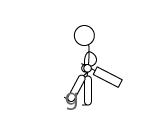|
The Rules
You have two sides, one out in the field and one in.
Each man that's in goes out, and when he's out he
comes in and the next man goes in until he is out.
When they are all out, the side that's been out comes
in and the side that's been in goes out and tries
to get those coming in, out. Sometimes you get men
still in and not out.
When a man goes out to go in, the men who are out
try to get him out, and when he is out, he goes in
and the next man in goes out and goes in. There are
two men called umpires who are all out all the time,
and they decide when the men who are in are out. When
both sides have been in and all the men have been
out, and both sides have been out twice after all
the men have been in, including those who are not
out, that is the end of the game.
That's almost as complicated as tennis!
Thanks to the Marlebourne Cricket
Club for "The Rules."
 |
|
That's Professor Basu kneeling in the front
row, second from the right. Third from the right
is Gary Kirsten, opening batsman for the South
African national team. Such tidy uniforms!
|
Thirsty for more?
A team comprises 11 men. Two batsmen are "in"
play at one time. Their aim is to hit the ball as
far as possible, and score points (runs) by running
the 22 yards between two sets of upright poles set
in the ground (wickets) while the fielding team chase
the ball.
If the batsman hits the ball past the boundary of
the field, he automatically scores 6 runs. The aim
of the fielders is to get the batsmen "out"
by: hitting the wickets by bowling the ball past the
batsman's guard, by catching the ball after the batsman
has hit it or by hitting the wicket with the ball
while the batsmen are running between wickets.
After the batting team are all "out" the
fielding team come "in." The team that wins
is the one with the most runs.
The Laws are enforced by referees known as umpires.
The most important players are the batsman, bowlers
and "wicket keepers" - the fielders who
are positioned behind the wicket.
To find out more about cricket....
Try CricInfo.com
|

